The Linux Foundation launched the LFCS certification (Linux Foundation Certified Sysadmin), a shiny chance for system administrators to show, through a performance-based exam, that they can perform overall operational support of Linux systems: system support, first-level diagnosing and monitoring, plus issue escalation – if needed – to other support teams.
Please aware that Linux Foundation certifications are precise, totally based on performance and available through an online portal anytime, anywhere. Thus, you no longer have to travel to a examination center to get the certifications you need to establish your skills and expertise.
The series will be titled Preparation for the LFCS (Linux Foundation Certified Sysadmin) Parts 1 through 33 and cover the following topics:
This post is Part 4 of a 33-tutorial series, here in this part, we will cover the partitioning storage devices, formatting filesystems and configuring swap partition, that are required for the LFCS certification exam.
Partitioning Storage Devices in Linux
Partitioning is a means to divide a single hard drive into one or more parts or “slices” called partitions. A partition is a section on a drive that is treated as an independent disk and which contains a single type of file system, whereas a partition table is an index that relates those physical sections of the hard drive to partition identifications.
In Linux, the traditional tool for managing MBR partitions (up to ~2009) in IBM PC compatible systems is fdisk command. For GPT partitions (~2010 and later) we will use gdisk. Each of these tools can be invoked by typing its name followed by a device name (such as /dev/sdb).
Managing MBR Partitions with fdisk
We will cover fdisk first.
# fdisk /dev/sdb
A prompt appears asking for the next operation. If you are unsure, you can press the ‘m‘ key to display the help contents.
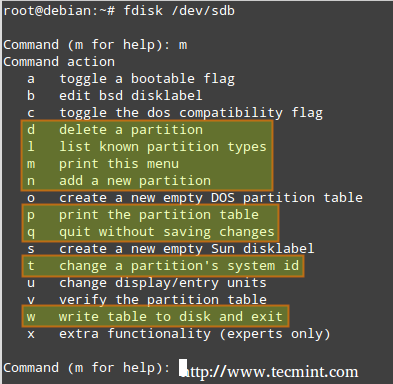
In the above image, the most frequently used options are highlighted. At any moment, you can press ‘p‘ to display the current partition table.
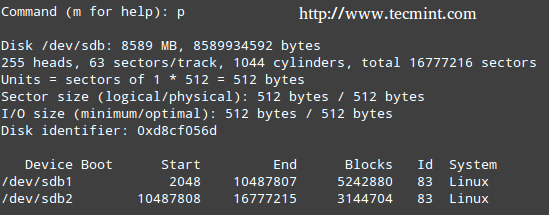
The Id column shows the partition type (or partition id) that has been assigned by fdisk to the partition. A partition type serves as an indicator of the file system, the partition contains or, in simple words, the way data will be accessed in that partition.
Please note that a comprehensive study of each partition type is out of the scope of this tutorial – as this series is focused on the LFCS exam, which is performance-based.
fdisk Command Usage
Some of the options used by fdisk are as follows:
- You can list all the partition types that can be managed by fdisk by pressing the ‘
l‘ option (lowercase l). - Press ‘
d‘ to delete an existing partition. If more than one partition is found in the drive, you will be asked which one should be deleted. - Enter the corresponding number, and then press ‘
w‘ (write modifications to partition table) to apply changes.
In the following example, we will delete /dev/sdb2, and then print (p) the partition table to verify the modifications.
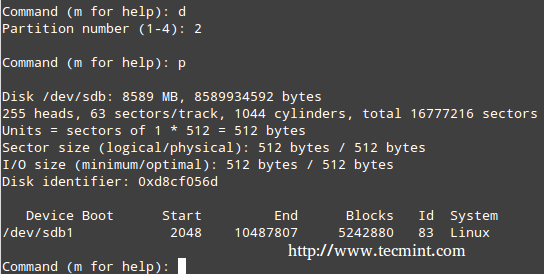
Press ‘n‘ to create a new partition, then ‘p‘ to indicate it will be a primary partition. Finally, you can accept all the default values (in which case the partition will occupy all the available space), or specify a size as follows.
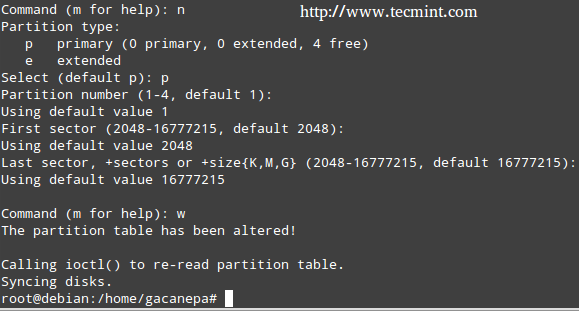
If the partition Id that fdisk chose is not the right one for our setup, we can press ‘t‘ to change it.
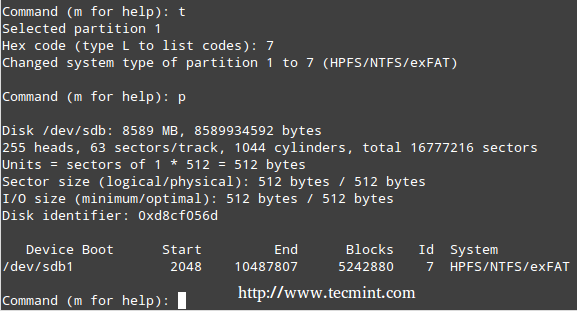
When you’re done setting up the partitions, press ‘w‘ to commit the changes to disk.

Managing GPT Partitions with gdisk
In the following example, we will use /dev/sdb.
# gdisk /dev/sdb
We must note that gdisk can be used either to create MBR or GPT partitions.
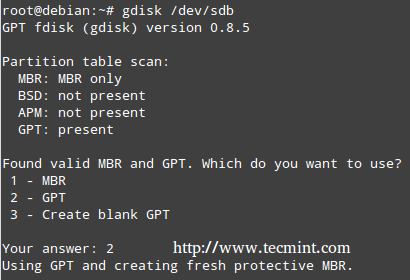
The advantage of using GPT partitioning is that we can create up to 128 partitions in the same disk whose size can be up to the order of petabytes, whereas the maximum size for MBR partitions is 2 TB.
Note that most of the options in fdisk are the same in gdisk. For that reason, we will not go into detail about them, but here’s a screenshot of the process.
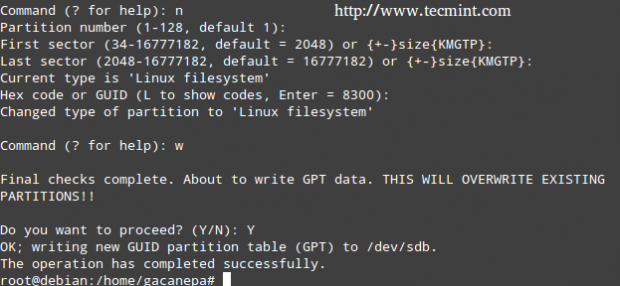
Formatting Filesystems in Linux
Once we have created all the necessary partitions, we must create filesystems. To find out the list of filesystems supported in your system, run the following ls command.
# ls /sbin/mk*

The type of filesystem that you should choose depends on your requirements. You should consider the pros and cons of each filesystem and its own set of features. Two important attributes to look for in a filesystem are.
- Journaling support, which allows for faster data recovery in the event of a system crash.
- Security Enhanced Linux (SELinux) support, as per the project wiki, is “a security enhancement to Linux which allows users and administrators more control over access control”.
In our next example, we will create an ext4 filesystem (supports both journaling and SELinux) labeled Tecmint on /dev/sdb1, using mkfs, whose basic syntax is.
# mkfs -t [filesystem] -L [label] device or # mkfs.[filesystem] -L [label] device
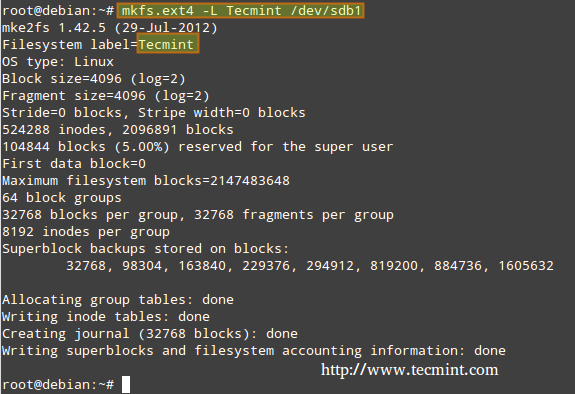
Creating and Using Swap Partitions
Swap partitions are necessary if we need our Linux system to have access to virtual memory, which is a section of the hard disk designated for use as memory when the main system memory (RAM) is all in use.
For that reason, a swap partition may not be needed on systems with enough RAM to meet all its requirements; however, even in that case, it’s up to the system administrator to decide whether to use a swap partition or not.
A simple rule of thumb to decide the size of a swap partition is as follows.
Swap should usually equal 2x physical RAM for up to 2 GB of physical RAM, and then an additional 1x physical RAM for any amount above 2 GB, but never less than 32 MB.
So, if:
M = Amount of RAM in GB, and S = Amount of swap in GB, then
If M < 2 S = M *2 Else S = M + 2
Remember this is just a formula and that only you, as a sysadmin, have the final word as to the use and size of a swap partition.
To configure a swap partition, create a regular partition as demonstrated earlier with the desired size. Next, we need to add the following entry to the /etc/fstab file (X can be either b or c).
/dev/sdX1 swap swap sw 0 0
Finally, let’s format and enable the swap partition.
# mkswap /dev/sdX1 # swapon -v /dev/sdX1
To display a snapshot of the swap partition(s).
# cat /proc/swaps
To disable the swap partition.
# swapoff /dev/sdX1
For the next example, we’ll use /dev/sdc1 (=512 MB, for a system with 256 MB of RAM) to set up a partition with fdisk that we will use as a swap, following the steps detailed above. Note that we will specify a fixed size in this case.


Conclusion
Creating partitions (including swap) and formatting filesystems are crucial in your road to Sysadminship. I hope that the tips given in this article will guide you to achieve your goals. Feel free to add your own tips & ideas in the comments section below, for the benefit of the community.
The LFCS eBook is available now for purchase. Order your copy today and start your journey to becoming a certified Linux system administrator!
| Product Name | Price | Buy |
|---|---|---|
| The Linux Foundation’s LFCS Certification Preparation Guide | $19.99 | [Buy Now] |
Last, but not least, please consider buying your exam voucher using the following links to earn us a small commission, which will help us keep this book updated.

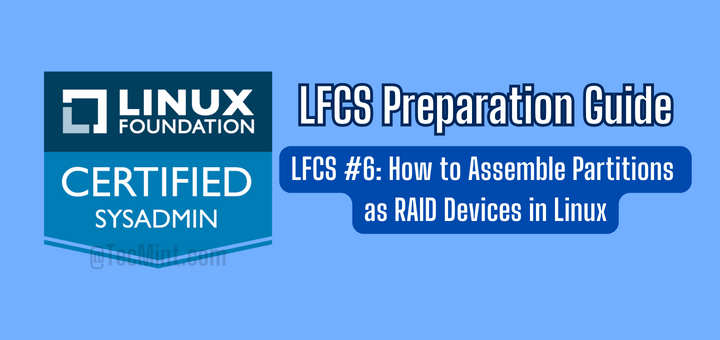
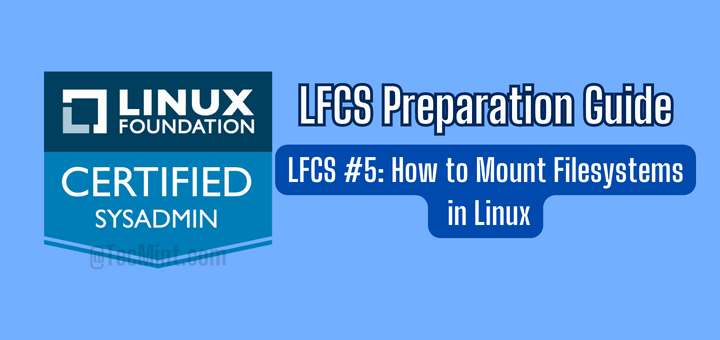
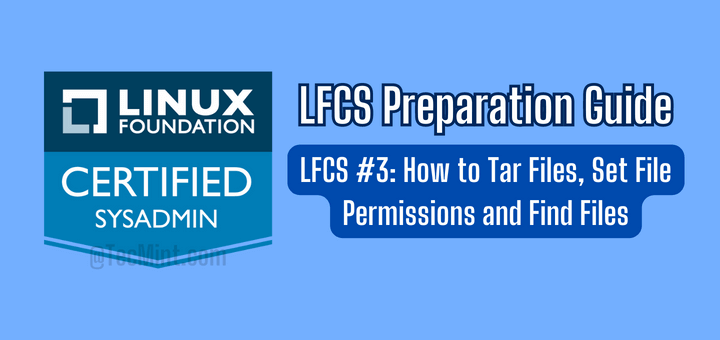
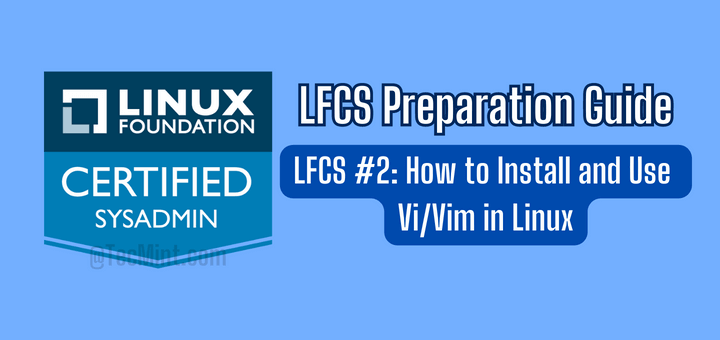
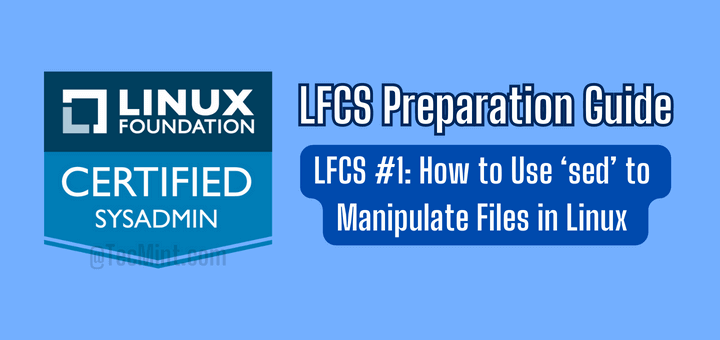
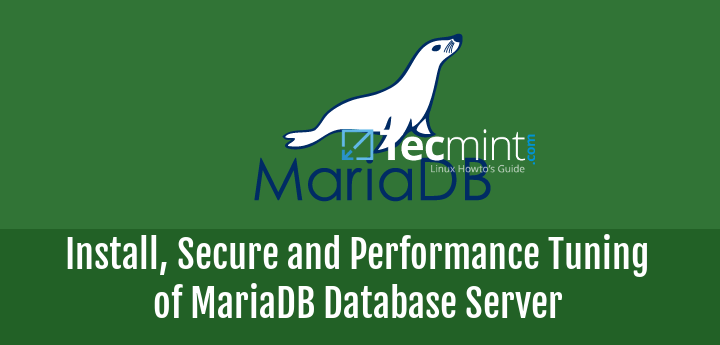
When I ran the following command on Centos 7 running on VirtualBox.
It gives me this error:
I decided to split the command in to two:
It worked.
Correct me if I am wrong, but when you make a swap partition, shouldn’t you change its time to Linux swap ( Hex 82) ?
Type * not time… sorry
I didnt have fdisk on my recently installed centos 7 (easily installed via yum) however in fdisk it appears to now have options to manage GPT partitions.
Command action
a toggle a bootable flag
b edit bsd disklabel
c toggle the dos compatibility flag
d delete a partition
g create a new empty GPT partition table
G create an IRIX (SGI) partition table
l list known partition types
m print this menu
n add a new partition
o create a new empty DOS partition table
p print the partition table
q quit without saving changes
s create a new empty Sun disklabel
t change a partition’s system id
u change display/entry units
v verify the partition table
w write table to disk and exit
x extra functionality (experts only)
@Peter,
To be honest, I had not noticed this before. What is the fdisk version currently installed on your CentOS 7 system?
When I run fdisk -v I get the following:
fdisk from util-linux 2.23.2
@mike,
Feel free to test yourself. Gdisk can be used to create both types of partitions.
i think this is wrong “We must note that gdisk can be used either to create MBR or GPT partitions.” gdisk can only create GPT PARTITIONS. Parted can create both
Thanks it is nice to see all the objectives covered in details.
@Khoi and @santosh,
Thanks for your comments! Feel free to share this post (and the rest of the series) through your social network profiles.
Best regards,
Gabriel
thanks
Thank you Gabriel Cánepa, it very nice.
@Javid,
Thank you for your kind words. Feel free to help us spread the word about this series by sharing on your social network profiles!
Great thanks you for article